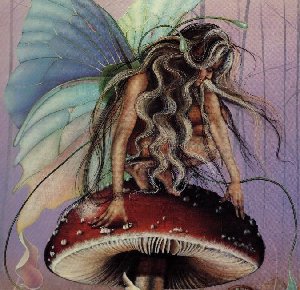Foxglove
Name is derived from "Little Folks' Glove". Florets are worn by Faeries as hats and gloves.
Primroses
Make the invisible visible. Eating them lets you see Faeries. If one touches a Faerie rock with the correct number of primroses in a posy, the way to faerieland and Faerie gifts is made clear. The wrong number means certain doom.
Ragwort
Used as makeshift horses by the Faerie.
Wild Thyme
Part of a recipe for a brew to make one see the Faeries. The tops of the Wild Thyme must be gathered near the side of a Faerie hill.
Cowslips
These are loved and protected by the Faeries. They help one to find hidden Faerie gold.
Pansies
the flower that was used as a love potion by Oberon, a Faerie king thought to have been invented by Shakespeare.
Bluebell
One who hears a bluebell ring will soon die. A field of bluebells is especially dangerous, as it is intricately interwoven with Faerie enchantments.
Clover
A four-leafed one may be used to break a Faerie spell.
St. John's Wort
Has a calming effect, used when stress is overwhelming. Helps break spells as well.
Hazel
Celtic legend says it is the receptacle of knowledge; the hazelnut is a symbol of fertility in England.
White Oak Bark
Cleanses and tones entire alimentary canal (tract that food passes through from ingestion to elimination), excellent astringent. Good for external and internal hemorrhage - bleeding in stomach, lungs, rectum.
Rowan
Protects against bad spirits. Used in butter churns so that the butter would not be overlooked by Faeries. Bewitched horses may be controlled by a rowan whip. Druids used rowan wood for fires with which they called up spirits whom could be forced to answer questions when rowanberries were spread over the flayed hides of bulls.
|
 |
|
|  |
Buckthorn
Made from bark, aids liver congestion, helps to carry blood and liver toxins out of the body. Good for gall stones, lead poisoning.
Oak
Oakmen are created when a felled oak stump sends up shoots. One should never take food offered by them since it is poisonous.
Willow
At night they uproot themselves and stalk travelers, muttering at them.
Elder
Sometimes is a witch disguised as a tree. Never lay a baby in an elderwood cradle or the Faeries will pinch them so they bruise. Burning elder wood is dangerous since it invites the Devil.
Birch
If the spirit of the birch tree (The One With the White Hand) touches a head it leaves a white mark and the person turns insane. If it touches a heart, the person will die.
Alder
Protected by water spirits.
Apple
To ensure good harvests, leave the last apple of your crop for the Apple-Tree-Man.
Ash
Druids wands were made of ash twigs. It also has healing properties. Weak-limbed children were passed through split ash trees which were then bound up. If the tree grew straight, the child would as well. Also may be used as a substitute for Rowan.
Toadstools
Some have poisonous hallucinogenic properties. The Vikings ate it and gain their reputations as berkerkers. In Celtic lore, they are among the food of the gods, as with many red plants. Some toadstools associated with the Faerie are Fly Agaric, Yellow Fairy Club, Slender Elf Cap, Dune Pixie-Hood, and Dryad's Saddle.
Fairy Ring Mushroom
Marks the boundaries of Faerie rings.
 |
 |
|
|